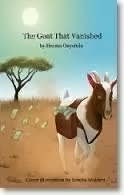Ifeoma Onyefulu is the author of many children's books, including Ikenna Goes to Nigeria and Here Comes Our Bride, both past winners of the Children's Africana Book Award; A is for Africa; and New Shoes for Helen. She lives in London.
Q:
How do you come up with ideas for your books?
A:
Sometimes conversations between fellow passengers on a bus in London where I
live could be the spark I need for a story, or the way someone says something on
the radio.
Also,
sometimes my publisher Frances Lincoln would suggest an idea, and I’d go away
and think about it; an example is Ikenna
Goes to Nigeria, which earned me a second CABA (Children's Africana Book
Award).
But
quite often an idea would pop into my head – especially when I’m doing
something less tasking – one day I was washing dishes and I heard a voice and
it said My Grandfather is a Magician,
so I wrote it down, but didn’t know what it meant; some days later I realised
it was another book. So, I went to Nigeria in search of a place to set the
book.
The
texts always come first and then I’d go to any African country I think would
offer me the best photos for that particular book, for example for the books New Shoes for Helen and Omer’s Favourite Place I went to
Ethiopia and to Mali for my First Experience books.
Q:
Why did you decide to write for children?
A:
I decided to write A is for Africa,
my first book for my son, then aged 2, to show him what it was like growing up
in Nigeria. Most of the books set in Africa in our local library were about
animals, a few were about people, but they were so boring.
In
A is for Africa I decided to
highlight the items that would best show cultural and traditional lives; for
example, in this book, I is for Indigo shows the traditional way of dying
clothes and M is for Masquerade, a mask and costume made to honour the spirit
of an ancestor.
Some
of the items in the book were not strictly about culture, but are some items
familiar to people who aren’t from Nigeria or Africa, for example, C is for
Canoe and D is for Drums, and yet there are lots that are still less familiar,
and ideal for discussions in the classrooms.
When
I do workshops I like to tell children about how I write, and I often bring
along my writing pad, which are full of crossed-out words and terrible writings
and of course some proofs complete with hand written notes by my editor.
I also do storytelling; ghost and animal
stories are usually popular, and of course the cunning tortoise features
heavily.
Q:
What are you working on now?
A:
Actually, I’m working on online short stories. I’ve written two at the moment –
The Goat that Vanished and What the Orange Seller Saw.
The Goat that Vanished is set in a village where
the elders used to command huge respect; anything they ask is given to them
unopposed but when they demanded a gift of a cow, as was the tradition when
someone well known died, young people there refused. They preferred to give
them a goat instead. Unfortunately the delivery of the goat didn’t go according
to plan.
What the Orange Seller Saw is about a boy, who discovers
lots of money hidden beside an old barrel, while selling oranges for his mother,
and decides to keep it. Soon, two men on motorbike, who had hidden the loot, gave
chase.
I’m also working on another book, which will
be illustrated with my photos and set in a city like Lagos. Finally, I’d love
to do a photography exhibition in America.
--Interview with Deborah Kalb







No comments:
Post a Comment